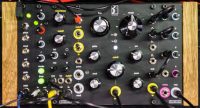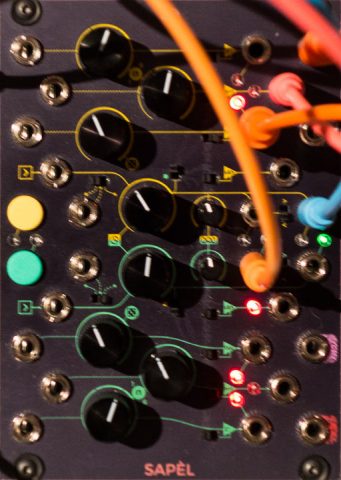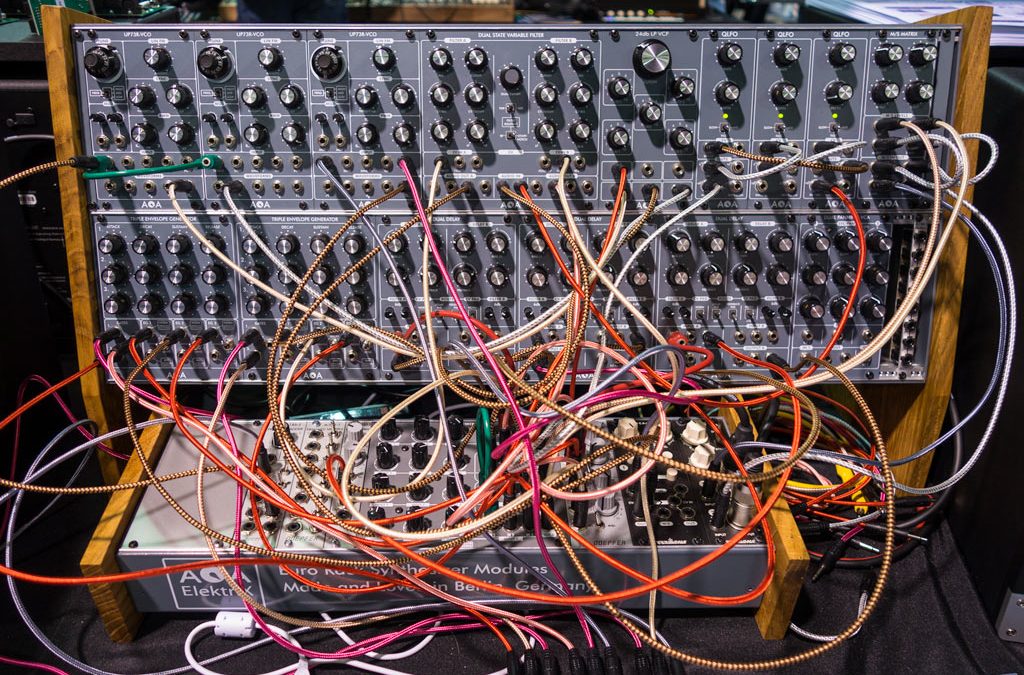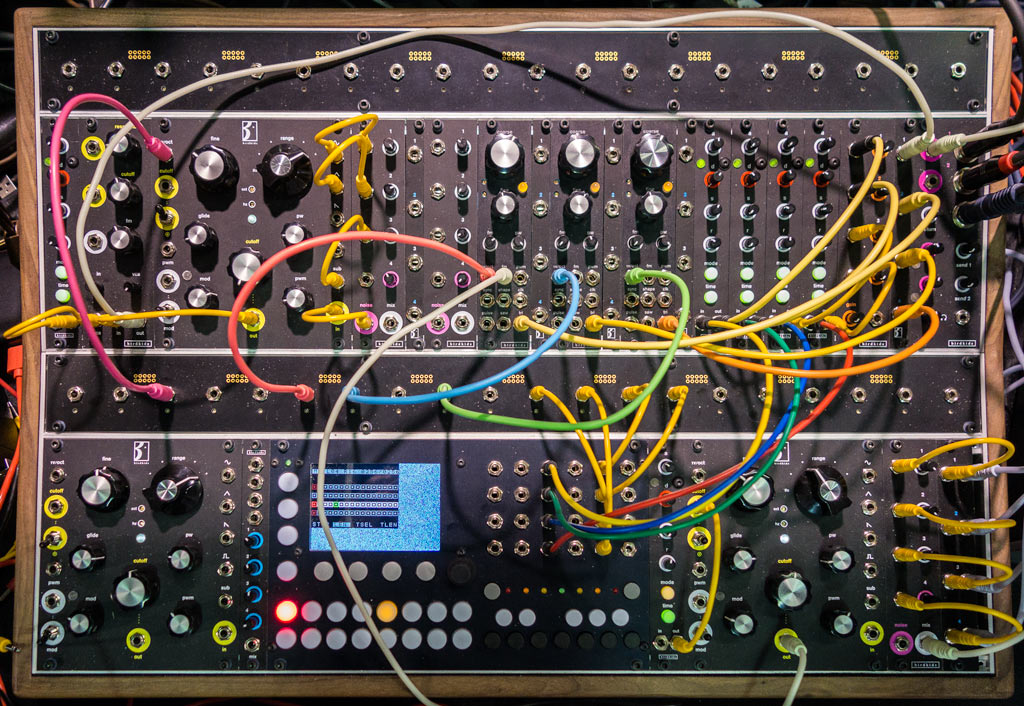In addition to the large #5000 both that WMD organizes for other small American Eurorack manufacturers, overseas distributor ALEX4 hosts their own superbooth at NAMM featuring a wide variety of manufacturers we don’t see as often on this continent. Many of them – like AJH Synth, covered in a previous installment – focus on higher end modules with a focus on features, sound quality, or both. I’m going to look at four of those companies here. (I’m going to be a bit more vague than usual about prices and shipping dates, as currency conversions and overseas distribution throws some big variables into those numbers.)
AQA ElektriX
I spoke with Stefan Lewin of AQA ElektriX, who filled me in on a new module he’s working on: a 24dB/oct low pass filter based on an all-discrete transistor ladder design. Each filter pole – 6bB, 12dB, 18dB and 24dB – will have its own output. It is capable of self-oscillation, meaning it can become a quadrature output sine wave VCA (as each filter pole introduces a 90° phase shift). There will be compensation to optionally restore the level and bass response at higher resonance settings. It will be a very clean filter by design, but can be overdriven for saturation. This new filter will have a completely different sound than their very first module – the 24dB LP VCF – of which only 15 were built; the new design has less inherent distortion, and if saturated it has a completely different character to its distortion.
Nikolai from AQA ElektriX is also working on a very high quality output module, and also featured a Dual Panning VCA in the rack above that is new. Although it’s hard to truly evaluate sound quality on the NAMM show floor, the sequenced patch he was playing in the booth overall sounded very tight and precise while maintaining a strong, well-rounded bass.
birdkids
Birdkids is both a modular synth manufacturer and a record label. Its founder Michael Beim emphasizes that he is not a career engineer but instead a producer and performer. Therefore, his focus has been on both the playability and sound quality of the modules he produces. His offerings fall into three product lines:
- The original Bateleur line of modules, anchored by their powerful VCO + VCF voice (click here for a excellent primer by DivKid Ben Wilson).
- The Birdnest line, which includes a modular mixer as well as other slim support modules.
- The Signature Series of modules designed in collaboration with other artists, programmers, and engineers.

The Birdnest line includes a component-based studio quality mixer that features several I/O choices (including a balanced I/O with transformers, which I’m personally interested in) as well an auxiliary bus and a quad VCA. Several companies have been offering modular-mixing systems that allow the user to configure the number of inputs et al that they need.
The Signature Series includes a brand new 6hp analog sawtooth core VCO with PWM, sync, FM, “shape”, and pulse, sawtooth, and triangle outputs that produced a wide range of sounds. The line will also include a filter (not shown at NAMM) and a four channel digital sequencer with numerous outputs per channel. The interesting twist about the Signature Series (at least the VCO and VCF) is that they will also be available as kits. These should be released staggered over the next three months.
The system on display also contained a pair of wide 1U multiples that Michael downplayed when I asked him about it, but he did mention that their system would have an internal bus to make patching and live performance cleaner and easier to manage.
Frap Tools

The green and yellow sections that take up the majority of the module’s faceplate are a pair of random voltage generators with four different outputs each: a smoothly fluctuating random voltage, a sample & hold for stepped random voltages, and a pair of quantized random voltages that are very similar to those from the classic Buchla 265/266 Source of Uncertainty with user-adjustable distribution of the random values. These two sections also feature a built-in clock with a normal and random outputs, as well as external clock inputs and manual trigger/hold buttons (which may also be externally gated). Along the right side of the module are four noise outputs, featuring blue, white, pink, and red (Brownian) noise.
I’ve come to really appreciate random voltage modules in my personal system (a Sputnik West Coast Random and Elby Designs ChaQuO being my current favorites); SAPÈL sets a new standard in this area. The price has not been announced yet; shipping is “spring.”
Frap also showed their new 333 ProAudio Sum & Distribution module ($99; shipping soon), which contains three section that each precision-adds three incoming signals and presents them on three buffered outputs. They’ve added normalizing between the sections so the top section can feed the one below and so on; each section also contains a 6dB pad switch that cuts the output level in half for that section. It is DC coupled with input impedance of 100k and output impedance between 50 and 100 ohms (click here for why these numbers are so important to me). In short, it’s suitable for both audio and control voltage mixing and mult-ing, including pitch voltage signals.
Endorphin.es
Endorphin.es is probably best known for their Furthrrrr Generator complex oscillator, but it’s possible now to put together an entire Endorphin.es system from MIDI in to audio out. In fact, they have done just that: At NAMM they were showing both individual modules (top row in the picture above) and their new Shuttle System (the bottom row) that puts everything – the Shuttle Control MIDI interface and modulation center, Furthrrrr Generator complex VCO, Grand Terminal dual envelope generator/VCF/VCA/effects module, Gateway T_XP expander for the Grand Terminal (which includes an oscillator auto-tuning function that can be used with other oscillators in your system), and Cockpit output mixer – behind one panel in a customized Frap Tools 84hp desktop case.
I spent a lot of time talking to Moritz Scharf about the new Grand Terminal. Whereas the previous Terminal module was part analog and part digital, the Grand Terminal is fully digital (stereo 48kHz 16-bit), which allows them a lot more flexibility in what they can implement including the ability to perform firmware updates over USB. For example, it now features a dual filter with several different models – ladder, diode, vactrol, and a state variable filter with low-pass, high-pass, bandpass, and comb filter modes – that can be configured as dual mono, stereo, or serial (one after the other) with volume and panning. One of the advantages of being implemented digitally is that as you switch between filter modes, each mode remembers its previous settings. It retains the AD/AR/looping envelope generators of Terminal with shapes variable between exponential, linear, and logarithmic per stage (a very nice feature), but has a new stereo “Cabin Pressure” effects section featuring reverbs (including a spring reverb emulation) in addition to Terminal’s multitap delay. The envelopes even feature 1v/oct tracking for their stage durations, allowing you to use them as simple oscillators. The stereo headphone output (as well as normal modular outputs) is retained. Click here for their video that runs through its features. It is available now; the price is 650 Euro overseas and 650 US dollars on our side of the pond.
Also new at Endorphin.es is their Cockpit 6hp mixer module (259 Euro) with 4 mono or stereo channels. It lowers modular levels to those needed to connect to external devices, and mixes it with other lower-level inputs from your other instruments and effects. It has a built in compressor and high-level headphone output, and features a 4 channel TRRS connector for two channels of send and return to an iOS device should you wish to use one as an outboard effects processor.
Showing how so many companies work together, not only does Endorphin.es use a Frap Tools case for their Shuttle System, they made a point of introducing me to Michael Bein of birdkids so I could get a demo of his modules as well.
There’s still more to come, including new offerings from 4ms, Detachment3, Doepfer, Eventide, Koma, Make Noise, Moon Modular, Noise Engineering, Tom Oberheim, STG Soundlabs, Synthrotek, Vermona, and WMD. Better get back to work…



